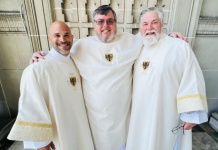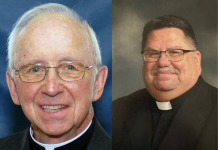Column by Jonathan Nagy
In 1921, British mountaineer George Mallory set out on an expedition attempting to become the first man to climb to the top of Mount Everest. While the group did not ascend the summit on that first trip, they came close enough to plot a plan for a second journey a year later. Unfortunately, that climb also did not meet the ultimate goal. In 1924, Mallory was preparing for a third trip to the tallest mountain on Earth. He was asked, “Why do you want to climb Mount Everest?” He replied, “Because it is there.” Sadly, disaster struck on that trip and Mallory never made it off the mountain alive. However, even though he knew the dangers, he was willing to take the risk to achieve the seemingly unachievable.
Several years later, in 1953, Sir Edmund Hillary and Tenzing Norgay accomplished that which Mallory was unable. They reached the summit of the world. When asked about his journey, Norgay responded, “In the mountains, worldly attachments are left behind, and in the absence of material distractions, we are opened up to spiritual thought. We should be attempting to carry the spiritual experience of the mountains with us everywhere.”
While most people will never attempt the phenomenal feat that these men did, we all have lessons to learn in our lives from their experiences. Mountains are often used as metaphors. Individuals speak of mountains in their experiences. A quick search of the internet yielded dozens of stories and anecdotes that use this figure of speech to explain life’s difficulties. One thought by Chris Thomson, a wellness teacher, struck me. Thomson wrote, “Mountains are a wonderful metaphor for the challenges we encounter in life, and for the way we meet them. They are also a metaphor for the many opportunities and possibilities that come our way, and for the way we take advantage of them. When we climb mountains, we sometimes must face our deepest fears and find ways of overcoming them. In doing so, we get to know ourselves better, but we also learn more about our potential – what we could do, if we really put our mind to it.” Our own personal mountains can seem insurmountable, whether we are a student struggling to study, a young adult looking for a job or love, a parent stressed about raising a child, or an individual fraught with anxiety over one of the many changes in life. These mountains can seem large and directly in our line of sight, with no light and no promise of ever overcoming them. We struggle to know where to turn for help.
I have a motivational sign in my house that reads, “Don’t measure the size of the mountain. Talk to the one who can move it.” What a powerful thought that is! God made the literal mountains and has placed figurative mountains in our lives. He never intends for us to climb these mountains alone. George Mallory and Sir Edmund Hillary used Nepalese Sherpas, people known for their superior climbing skills and endurance of high altitudes, to help guide them up Everest. God is there as our Sherpa. We only but need to reach out to him for assistance and accept his guiding hand.
In no less than two dozen occurrences in the Bible, Jesus was either referenced in ascending or discussing mountains. Several times, he climbed a mountain to seek peace and solitude to pray. At times, he climbed a mountain or hill to have a vantage point allowing everyone listening to his word to see him. In the Gospel of Matthew, Jesus is quoted as saying, “Because you have so little faith. Truly I tell you, if you have faith as small as a mustard seed, you can say to this mountain, ‘Move from here to there,’ and it will move. Nothing will be impossible for you.” – Matthew 17:20. In Mark 11:23, Jesus also spoke, saying, “Truly I tell you, if anyone says to this mountain, ‘Go, throw yourself into the sea,’ and does not doubt in their heart but believes that what they say will happen, it will be done for them.”
Jesus was human and spoke often of the realization of the mountains in our lives. Some of his best friends had huge ‘mountains’ to overcome, including Peter, Mary Magdalene, Thomas, and others. He gravitated towards those who struggled with the turmoil presented to them, from the lepers, to the blind man, to Nicodemus. All the while, Jesus knew He had His own mountain in His journey, but never lost focus of helping others.
I believe that the challenge presented to us is twofold. First, we need to face our mountains head on without fear. Possessing the knowledge that God is with us every step of the way should come as a comfort in believing that we can achieve anything that life presents to us. Secondly, we must realize that others may not have as strong of faith, willpower, or have some other earthly hindrance to overcoming their own mountains. As Christians, we must step up to reach out to those who struggle and do so in the most loving way. In the parable, Jesus spoke of the one lost sheep that the shepherd does not give up on finding as a way to relate to the people how God never gives up on any of us. We should never give up on our fellow humans either.
Mr. Rogers once said, “How sad it is that we give up on people who are just like us.” So often, we find ourselves exclaiming, “I am done with them!” or “I can’t help them!” or “I have washed my hands of them!” Mr. Rogers was correct in pointing out how quickly we give up on others and trying to help them navigate a path through life. He further illustrates our significance to others by saying, “If you could only sense how important you are to the lives of those you meet; how important you can be to the people you may never even dream of. There is something of yourself that you leave at every meeting with another person.” How often we forget our interconnections with the rest of humanity! While we are all climbing different peaks, we are all on the same mountain!
Before that fateful final journey, George Mallory explained his ambitions in the following way: “The first question which you will ask and which I must try to answer is this, ‘What is the use of climbing Mount Everest?’ and my answer must at once be, ‘It is no use.’ There is not the slightest prospect of any gain whatsoever. It is no use. So, if you cannot understand that there is something in man which responds to the challenge of this mountain and goes out to meet it, that the struggle is the struggle of life itself upward and forever upward, then you won’t see why we go. What we get from this adventure is just sheer joy. And joy is, after all, the end of life. We do not live to eat and make money. We eat and make money to be able to live. That is what life means and what life is for.”
Let us never forget the lessons taught to us by the mountains placed before us. May we always accept God’s guidance in not only our own journey home to him but assisting others in doing the same.
Jonathan Nagy, M.Ed., is the Dean of Students and Social Studies teacher at Bishop Carroll Catholic High School in Ebensburg. He is also the Music Director at the Basilica of Saint Michael the Archangel in Loretto.































